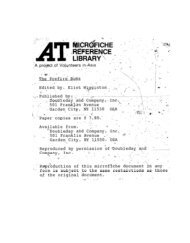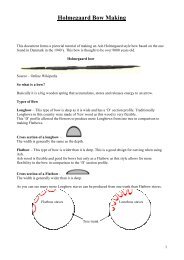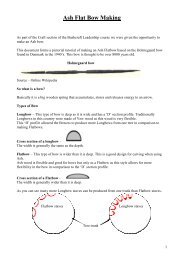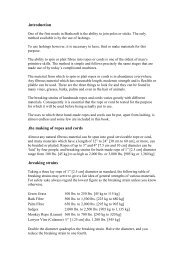Experiments on Knife Sharpening John D. Verhoeven ... - BushcraftUK
Experiments on Knife Sharpening John D. Verhoeven ... - BushcraftUK
Experiments on Knife Sharpening John D. Verhoeven ... - BushcraftUK
Create successful ePaper yourself
Turn your PDF publications into a flip-book with our unique Google optimized e-Paper software.
Even <strong>on</strong> freshly dressed wheels a 2β edge angle of 20 degrees was too small to givereas<strong>on</strong>able edge quality. At 30 degrees the results were <strong>on</strong>ly nominally acceptable, butabove around 35 degrees c<strong>on</strong>sistently good results were obtained.C<strong>on</strong>clusi<strong>on</strong>s1 The 1000 grit wheels produce a very smooth surface with a small burr al<strong>on</strong>g the edge.The burr width as viewed edge-<strong>on</strong> in the SEM is c<strong>on</strong>sistently in the 1 to 1.5 micr<strong>on</strong>range. The burr formati<strong>on</strong> appears to be an inherent feature of the sharpening acti<strong>on</strong> ofthe Tru H<strong>on</strong>e machine. It cannot be reduced in size by employing very small addedgrindings at slightly larger 2β angles. Low speeds appeared best for uniform grinding,but varying the final wheel speeds between 1 and 2 did not have a statistically observableeffect <strong>on</strong> the burr width.2 The 600 and 200 grit wheels produced surfaces that were difficult to tell apart. In bothcases the face abrasi<strong>on</strong> marks were significantly larger and the edge burrs significantlywider and more c<strong>on</strong>voluted than found with the 1000 grit wheels. In additi<strong>on</strong>, the faceview of the edges were significantly rougher and less straight than <strong>on</strong> the 1000 gritwheels. Nevertheless, the edges produced by the 600 and 200 girt wheels are quite thin,with a burr width <strong>on</strong> the order of 2 to 3 µm <strong>on</strong> the 600 wheels and 2 to 4 µm <strong>on</strong> the 200wheels. And, from a practical point of view, the edges are quite sharp, being able to cutarm hair as well as the 1000 grit edges. Neither cut hair as easily, however, as a razorblade. This later fact is probably due in large part to the much smaller edge angle of therazor blades, 2β of 17 o versus 40 o .3 Optimum edge formati<strong>on</strong> requires the wheels to be c<strong>on</strong>centric with the rotating shaft sothat there is no moti<strong>on</strong> of the wheel surface al<strong>on</strong>g the radius up<strong>on</strong> rotati<strong>on</strong>. Such moti<strong>on</strong>produces edges that undulate al<strong>on</strong>g the edge length. The undulati<strong>on</strong> effect is mostpr<strong>on</strong>ounced when using the wheels with the smallest overlap, which is required for thesmallest 2β angles. The undulati<strong>on</strong>s observed in these experiments were minor at 2βvalues of 35 to 45 degrees. However, at 2β edge angles of around 30 o and less theundulati<strong>on</strong>s became too severe to allow satisfactory sharpening.11








